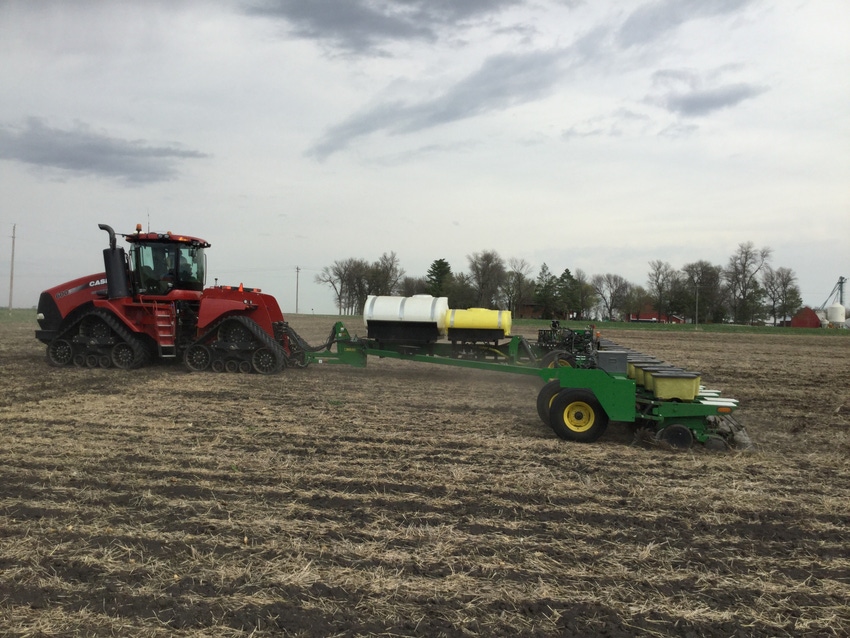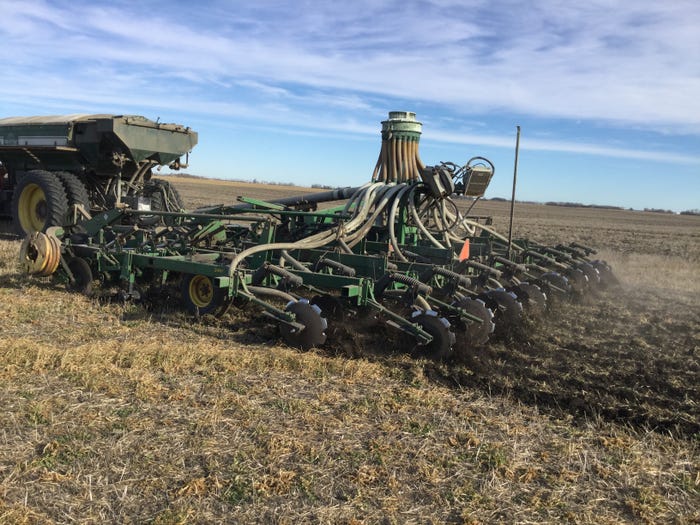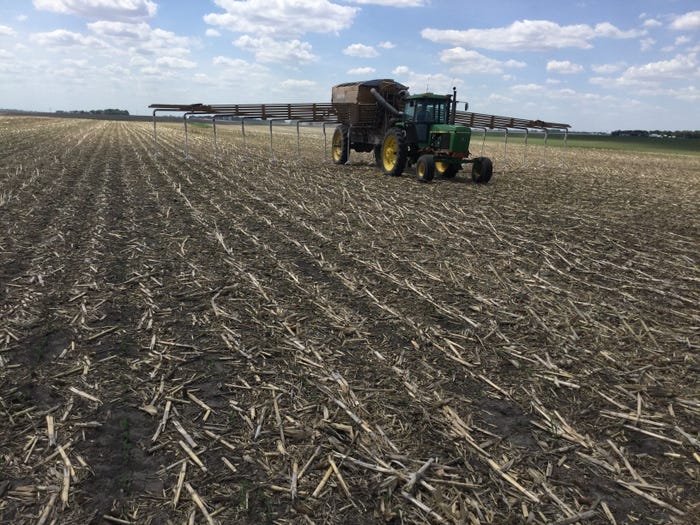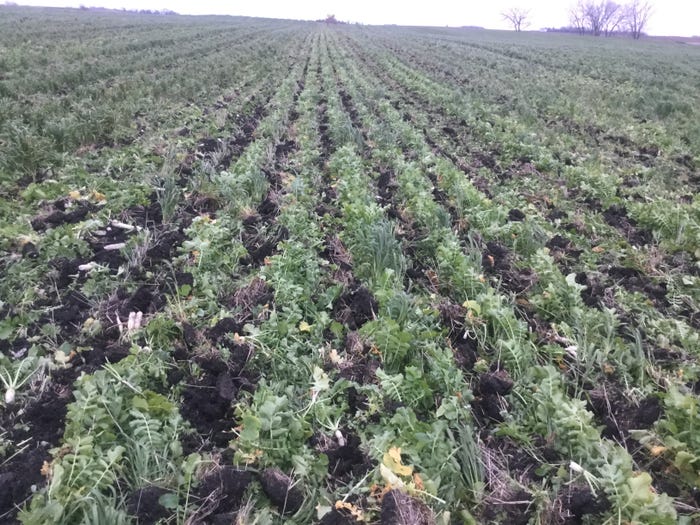April 20, 2018

------------
Think Different
Map and record every action on every acre.
Utilize new technology, not necessarily new equipment.
Project cash flow on every crop and every field separately.
Value mistakes for what you can learn from them, whether from a wrong rate or running out of product on a final pass.
Learn to build the equipment you can't justify economically, in order to take advantage of agronomic advances.
------------
It's all about the numbers for Don Bot. The Cottonwood, Minn., strip-tiller says he drives his computer more than his tractor. But when he enters the cab, one goal is more and better data to analyze. Every field is set up as a trial plot of one kind or another, and his equipment is set up to support that intention.
"We plant 36 rows on 22-inch spacing with individual seed hoppers so we can plant 12 rows of one hybrid, 12 of another and 12 of a third across the field for side-by-side comparisons," says Bot, who farms with his son Chad. "With planting maps on iPads, we can walk across the field as they emerge and question why these 12 rows are different from the others."
Comparing new corn hybrids and soybean varieties against proven numbers gives the Bots real world data for the way they fertilize and crop the land. "With the rapid churn in hybrids, we question if seed companies have information we can actually use," says Bot. "Their test plots are not on land that has been strip-tilled or planted to cover crops."
Paper grid data in 1960s
Farming data is a philosophy Bot has maintained from his days as a college student, working part-time in the University of Minnesota soils lab. In 1966 there was no GPS, so he grid sampled a quarter-section by counting off fence posts and mapping his grid on paper. The results showed high levels of phosphorous (P) and potassium (K) around the livestock buildings, which dropped as he moved farther from them. That impressed his dad.
"He started telling the local coop to make extra passes around the edges of fields farthest from the buildings," says Bot. "He wasn't getting the yields there, and with the soil tests he knew why."
Like his dad, Bot takes action with data in hand. When his no-till fields weren't performing, he put together a strip-till rig in 1990. Bot mounted anhydrous knives and a cold-flow type attachment on a John Deere planter frame and pulled an anhydrous tank behind it. The planter units were removed, but dry fertilizer hoppers stayed, allowing him to apply a blend of P and K.
Results were positive, and he soon added a second set of dry hoppers to variable rate P and K using hydraulic drive systems. His controller was literally an office computer on the tractor dash. Data was on floppy discs.
Narrow rows, more tech
Through the years Bot has adopted and adapted technologies from GPS and yield monitors to on-board controllers and moved from 30-inch corn and drilled beans to 22-inch row spacing for both. When his son returned to the farm about ten years ago, they doubled the acreage to their current 1,700 acres. They built an 18-row strip tiller and 36-row planter, much of it from salvaged or repurposed components along with select new technology, openers and more.
The fertilizer cart is an old Ag Chem fertilizer box mounted on a recycled bridge I-beams frame and an old combine front axle. The four-bin box holds nitrogen (N), sulfur (S), P and K. Two micro bins were repositioned to the rear of the box, plus two more were added to supply zinc, copper, manganese and boron. All eight compartments are individually controlled by an Ag Leader system for independent straight rates or variable rates.
"I seldom buy new equipment as it is hard to justify with our size operation, but I like to add new technology to the equipment I build," says Bot. "Our latest planter has a new frame with older planting units. This year we’re adding four new SmartFirmers from Precision Planting on our corn planter. The sensors will let us record moisture and soil pH as well as electrical conductivity. We don't know yet what we'll do with the data."

Don Bot applies individual rates of nitrogen, sulfur, potash and phosphorous as well as four micro-nutrients through his shop-built 18 row on 22-inch centers strip-till system.
Bulk fertilizer savings
While transitioning to strip-till quickly proved itself nearly 20 years ago, Bot says he would have no problem justifying it today, and he has the numbers to prove it. He estimates the homemade strip-till rig cost he and his son around $100,000, with technology add-ons and software adding $20,000 to the cost.
Since they apply their own fertilizer, the Bots use an old hog house with flat concrete floors for bulk fertilizer storage. Even with their $15,000 used tender truck, a $5,000 loader and approximately $10,000 in maintenance, total costs are around $150,000 – spread across both father and son's fields.
Bot estimates that buying fertilizer by the semi for his 900 acres saves approximately $50 an acre on his corn/soybeans/wheat rotation. "Buying fertilizer in bulk adds another $45,000 to my bottom line," he says. "If you have the storage and the need, why pay retail? Shop around for a bulk price."
He credits strip-till and variable rate fertilizer application for much of his 20 bushels over county corn averages and 10 bushels over county soybean averages. Multiply 300 acres times 20 bushels at $3 per bushel and 300 acres times 10 bushels at $10 per bushel, add in the fertilizer savings and Bot figures the yearly advantage of his system at around $93,000 on his farm alone. Add in the fertilizer used on his 300 acres of wheat and the advantage of buying bulk grows even more.

Bot repurposed an old Soiltec fertilizer box and air flow unit, mounting it on a shop-built cart. Drop tubes deliver fertilizer directly over these newly emerged, strip-till soybeans.
Wheat, cover crops added
Bot gives some of the credit for added corn and soybean yield to the rotation to wheat. Not only does the wheat more than pay for itself, but it also spreads out the planting and harvest work load. As a bonus, it lets him strip-drill a cover crop of radish and peas early enough it can get well-established before winter kill.
"With the radish in the grass seed box and field peas in the grain box, I can close off tubes and place a row of radish and two rows of peas next to where the following year's corn row will be," says Bot. "By the time I strip till in the fall, the radish roots are two to three inches in diameter and deep, while the peas are fixing nitrogen."
Bot estimates the impact on corn and soybean yields in the rotation and to soil health justify the practice, even if he didn't make any money on the wheat, but he does.
"We push the yields on the wheat, and we are getting good results," he says. "It works, but it is a long-term investment."

Bot is confident his long-term corn/soybean/wheat rotation helps boost corn and soybean yields. The late summer wheat harvest gives his preferred cover crop of radish and peas the opportunity to get well established before it winter kills.

Bot is confident his long-term corn/soybean/wheat rotation helps boost corn and soybean yields. The late summer wheat harvest gives his preferred cover crop of radish and peas the opportunity to get well established before it winter kills.
Variable rate N changes
As his capability for VRT application grows, when and how he uses it is shifting. With N, the shift started about 15 years ago. He had been using grid soil sampling and yield data as a base for variable rate N formulas and built application maps based on yield goals giving more N to more productive ground.
"The yield maps correlated closely to topography, with higher yields on lower ground," recalls Bot. "The higher the yield, the more N we applied, until we started running control strips with fixed rates of N."
"With the fixed rate strips, we discovered the variable rate N had been starving the hilltops, where less residual organic matter meant less available N," says Bot. "We still variable rate the nitrogen, but with more going on the hilltops to bring yields up, while gradually cutting rates over all with the goal of more bushels of corn per pound of nitrogen."
That experience simply reinforced Bot's emphasis on working the numbers. Since then, N application has shifted from fall to in-furrow and split applications in-season. Other changes include moving away from reliance on soil sampling to in-season tissue samples to evaluate crop needs. The Bots are also experimenting more with sulfur, in particular looking at different forms and trying foliar applications on soybeans, as well as experimenting with biologicals.
"With the tissue sampling, we are trying to learn what the plant is responding to," says Bot. "We may not make corrections in that crop year, but it will affect what we do the following year. The biggest advantage to mapping and recording every acre is being able to analyze what is happening on every acre."
About the Author(s)
You May Also Like




